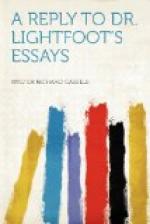It is generally admitted that the date of Trajan’s visit to Antioch is A.D. 115, when he wintered there during the Parthian War. An earthquake occurred on the 13th December of that year, which was well calculated to excite popular superstition. It may not be out of place to quote here the account of the earthquake given by Dean Milman, who, although he mentions a different date, and adheres to the martyrdom in Rome, still associates the condemnation of Ignatius with the earthquake. He says: “Nevertheless, at that time there were circumstances which account with singular likelihood for that sudden outburst of persecution in Antioch ... At this very time an earthquake, more than usually terrible and destructive, shook the cities of the East. Antioch suffered its most appalling ravages—Antioch, crowded with the legionaries prepared for the Emperor’s invasion of the East, with ambassadors and tributary kings from all parts of the East. The city shook through all its streets; houses, palaces, theatres, temples fell crashing down. Many were killed: the Consul Pedo died of his hurts. The Emperor himself hardly escaped through a window, and took refuge in the Circus, where he passed some days in the open air. Whence this terrible blow but from the wrath of the Gods, who must be appeased by unusual sacrifices? This was towards the end of January; early in February the Christian Bishop, Ignatius, was arrested. We know how, during this century, at every period of public calamity, whatever that calamity might be, the cry of the panic-stricken Heathens was, ‘The Christians to the lions!’ It maybe that, in Trajan’s humanity, in order to prevent a general massacre by the infuriated populace, or to give greater solemnity to the sacrifice, the execution was ordered to take place, not in Antioch, but in Rome.” [108:1] I contend that these reasons, on the contrary, render execution in Antioch infinitely more probable. To continue, however: the earthquake occurred on the 13th, and the martyrdom of Ignatius took place on the 20th December, just a week after the earthquake. His remains, as we know from Chrysostom and others, were, as an actual fact, interred at Antioch. The natural inference is that the martyrdom, the only part of the Ignatian story which is credible, occurred not in Rome but in Antioch itself, in consequence of the superstitious fury against the [Greek: atheoi] aroused by the earthquake.
I will now go more into the details of the brief statements I have just made, and here we come for the first time to John Malalas. In the first place he mentions the occurrence of the earthquake on the 13th December. I will quote Dr. Lightfoot’s own rendering of his further important statement. He says:—




